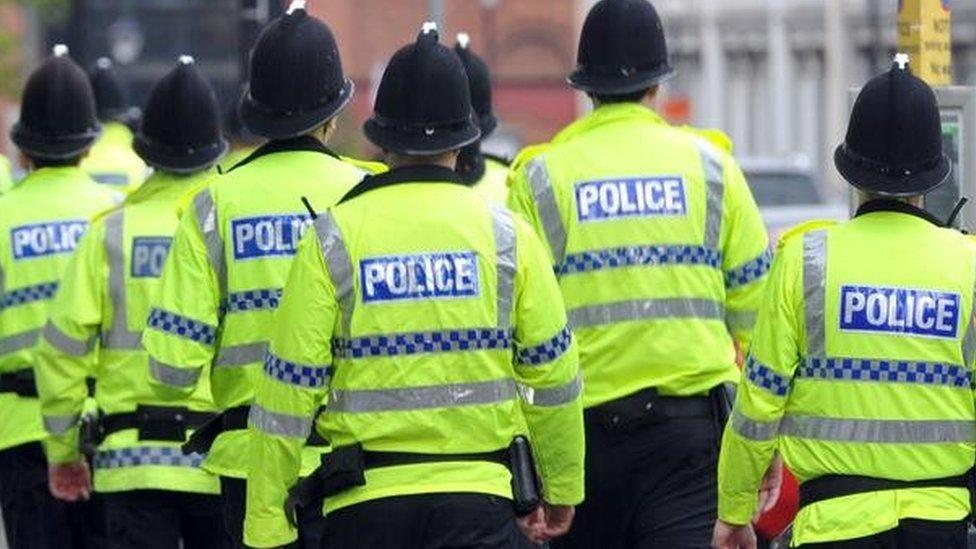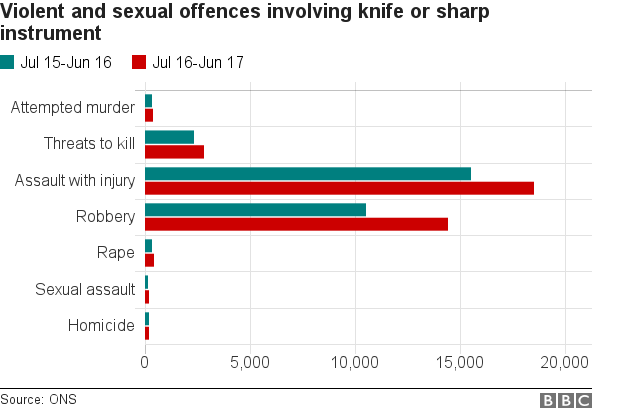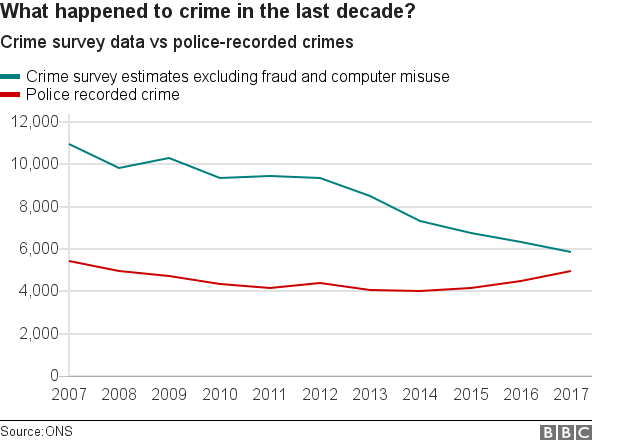Crime rises by 13% in England and Wales, ONS statistics say
- Published
- comments

The number of crimes recorded annually in England and Wales has passed the five million mark for the first time in 10 years, rising by 13%, figures show.
The Office for National Statistics said, external crimes in the 12 months to June were up from 4.6 million the previous year.
It said crime categorised as "violent" rose by 19%, with rises in offences including stalking and harassment.
The Crime Survey for England and Wales, based on people's experiences, suggests there were 10.8 million offences.
The survey includes crimes that people do not report to police. When comparing like-for-like crimes, the survey reported a 9% reduction compared with the previous year.
Have you been a recent victim of crime? Email us at haveyoursay@bbc.co.uk, external
The rise in the ONS statistics, which cover the 12 months to the end of June, is the largest annual rise in a decade and continues a recent trend of crime increases.
Both sets of data were released on the same day.
What kinds of crime are on the rise?

John Flatley, from the ONS, said: "While improvements made by police forces in recording crime are still a factor in the increase, we judge that there have been genuine increases in crime - particularly in some of the low incidence but more harmful categories."
But he said police figures alone cannot provide "a good measure of all crime in society".
"The recent increases in recorded crime need to be seen in the context of the overall decline in crime indicated by the Crime Survey for England and Wales," he said.
The ONS report said:
Knife crime was up 26% year-on-year
Nearly half of the increase in knife crime was attributed to London
Sexual offences were up 19%
The number of homicides (cases of murder and manslaughter) increased by 46 to 629, excluding the terror attacks in London and Manchester
There were 1.2 million crimes of violence against the person
The 19% increase in "violence against the person" offences dealt with by police was "driven largely" by increases in the sub-categories of "violence without injury" (21%) and "stalking and harassment" (36%) and "violence with injury" (10%), the ONS said.
Knife crime was up by 26% year-on-year - an increasing number of teenagers in London are being injured by knives
Crime minister Sarah Newton said "much" of the rise in violent offences was down to better crime recording.
However, she added: "We know that some of this increase is likely to be genuine. Which is why have taken urgent action to stop these crimes and keep our communities safe.
"This week we began consulting on tough new laws to crack down on acid attacks and knife offences. Our Domestic Abuse Bill will help to bring this heinous crime out of the shadows and ensure victims receive both support and justice, as we invest £100m to prevent and confront violence against women and girls."
She said the government was also investing £1.9 billion to counter the cyber-threats.
Scotland has a similar survey on perceptions of crime that runs every two years. In the most recent one, published in 2016,, external crimes committed against adults were down 16% since the previous survey in 2012-13.
Crimes recorded by the police in Scotland are at their lowest level since 1974.

Reality Check: Is crime up or down?

When we talk about crime rates we usually look at two things: police records and the number of incidents reported in the annual 38,000-person Crime Survey for England and Wales.
Neither is wrong but the more difficult question is which best represents how much crime is actually being committed.
The Crime Survey is generally considered a good measure of crime experienced by individuals because it is not affected by changes to how crime is recorded.
It also includes crimes that have historically been under-reported to the police.
However, it has some limitations. It does not cover crimes against businesses or people living in communal residences like care homes, prisons or student accommodation. It is also excludes crimes where there is no victim to interview, for example murders and drug offences.

Analysis: Can anyone explain the rise in crime?
By Danny Shaw, BBC home affairs correspondent
Three years ago the number of offences recorded by police in England and Wales fell to just over four million. Violent crime was on the decline and murders had fallen to levels not seen since the 1970s.
Together with a continuing reduction in offences estimated by the Crime Survey, some commentators said it reflected fundamental societal changes and even went as far as to suggest that crime was going out of fashion.
How different things are now.
Much of the increase in police-recorded crime since then is undoubtedly due to changes in the way officers register offences after the Inspectorate of Constabulary found that 800,000 incidents - one in five of all crimes reported - were not being logged.
But there are also real rises in the most serious types of violence - with killings and murders at the numbers they were nine years ago - and that is puzzling the experts.
No-one knows why it's happening.
One thing is certain though. It is putting huge additional demands on the police at a time when they are already very stretched.

- Published24 January 2019

- Published20 July 2017

- Published7 September 2017